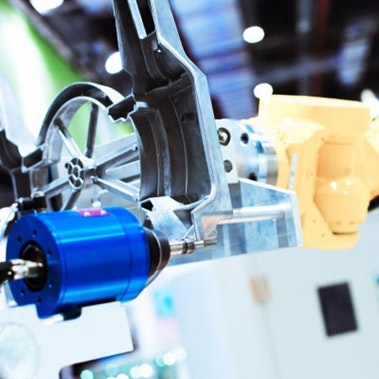Today, digital strategies need to demonstrate their impact and effectiveness quickly. This calls for agile development of minimum viable products (MVP): fast, implementable – yet powerful – digital solutions for testing strategic elements in a limited time frame. Even in B2B-dominated industries such as manufacturing, the time-to-market window for innovation and shrinking project timelines are key to differentiating and competing. B2B customers demand the same experience they are used to in the B2C world, such as flexible online modular product configurators, additive manufacturing methods, advanced digital remote services, and real-time big data analytics.
While most manufacturing companies have defined their digital strategy and identified promising use cases, only a few have managed to implement them thus far. The reason for this is that they often stick to classic waterfall approaches, which typically are not suited to quickly create results and demonstrate the impact of digital strategies.
Agile methods – applied correctly – could reduce the implementation time from an average of 18 months to only 12 weeks. That is because even in a first-step MVP, the result is a fully functional product (rather than simply a mock-up) that can then go live in a production environment, enabling end users to see and utilize it.
From Oliver Wyman’s point of view, a proven best practice consists in a three-step process that we call “Digital Fast Track Implementation”: the discovery phase for scoping and team setup, the agile implementation, and the scaling and further development of the MVP.
DISCOVERY PHASE
Typical digital use cases in manufacturing range widely. These can include the remote flow measurement in valves for estimating needed service and replacement; it may also reach full Internet of Things (IoT) platforms, connecting smart sensor data from multiple production-line machines and using advanced machine learning techniques. A thoroughly planned discovery phase helps to clearly define the scope of an MVP and should typically last between two and four weeks. (See Exibit 1.)
Exhibit 1: Agile piloting – mode of operation
Ability to rapidly pilot the meta models by focusing on cross-functional insights and on an agile development method
Source: Oliver Wyman analysis
Firstly, it is important to define the scope of the minimum viable product in an engaging format. This ideally entails a daylong offsite location with open innovation spaces to receive input and buy-in from involved stakeholders. Identifying candidates for a customer panel is critical, as well as engagement with them from Day 1.
Secondly, together with real clients (either internal or external ones), the user interface and experience need to be jointly developed to ensure the MVP delivers digital and enables strong adoption right from the start. Ideally, the user interface/user experience (UI/UX) can be tested with the customer panel in the form of quickly designed wireframes and clickable mock-ups. Successful ideation requires immediate prototyping – starting out “Low-Fi”, but becoming “Hi-Fi” quickly.
Third, the minimum data requirements to achieve scope must be identified, and the availability and accessibility of the data need to be evaluated. This represents one of the biggest challenges: dependencies on available skills and resources,on external suppliers as well as legal restrictions, need to be scrutinized thoroughly.
The overall outcome of the discovery phase is the identification of input parameters and prerequisites for the first agile sprint.
12 weeks are needed to deliver an impactful, fully functional minimum viable product, demonstrating effectiveness of the underlying strategy.
AGILE PROTOTYPING
An agile, cross-functional approach allows for quick turnaround. For this purpose, it is indispensable to set up a multidisciplinary, agile team. In addition, clear roles with regards to business ownership, product ownership, data architecture, and technical architecture, as well as test users and scrum master, need to be clearly defined upfront.
Subsequently, in a matter of eight to 10 weekly sprints (with continuous user testing), the first MVP will be developed and deployed in a rapid, iterative fashion. User feedback and user behavior need to be continuously analyzed when planning the next sprint session. During the review and challenge sessions at the end of each sprint, different stakeholders (from top management) should be included to demonstrate progress and increase senior buy-in.
Early embedding of the MVP into the existing system and process landscape is key to ensure smooth implementation and to realize high adoption rates from the beginning. It is critical to set up a realistic testing environment and interact frequently with users of the MVP to define appropriate
guidelines. These might include notes on the number of users, realistic context and time settings, a moderator to observe testers, and a suitably designed questionnaire to capture testers’ feedback. In the above-mentioned example, the usability of a first maintenance and service report produced by the intelligent valves is verified with internal service departments and real customers (such as plant engineering/construction companies).
SCALING PROTOTYPES
Developing and rapidly implementing an MVP prototype is a powerful way to demonstrate digital impact, but a subsequent roadmap is needed to drive further development from “MVP” to “fully-fledged”.
The focus needs to be on a continuous injection of new ideas through rapid deployment and testing. Each result needs to be scalable to a productive, client-facing solution.
In addition, technology architecture needs to evolve to support the platform. This may include the rationalization of legacy infrastructure and tool investments, cloud, test automation, DevOps, and IoT platform. Moreover, the existing workforce should be trained on new practices and – if required – supplemented with additional talent.
Organizational realignments will be required to draw business, support functions, and IT into permanently integrated teams and enable the long-lived application of MVP prototypes. In our example, this could mean adding functionality to display real-time information on handheld devices about the valves and their maintenance requirements, including automated scheduling with service teams for on-site replacements or repairs.
While the digital fast track process is a reliable method, early customer adoption and feedback cycles remain key to proving viable customer benefits for manufacturing companies.








